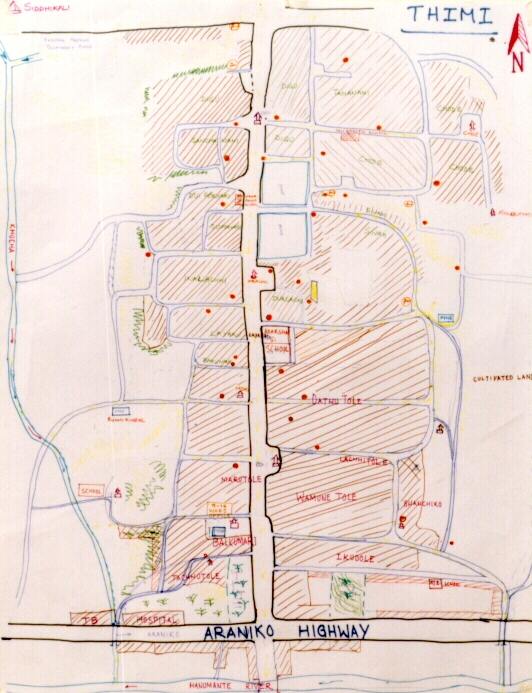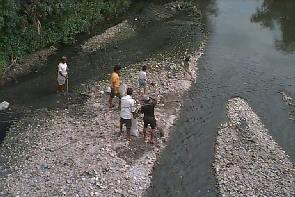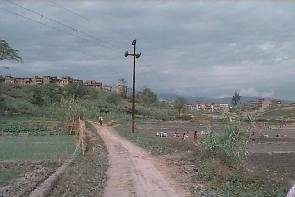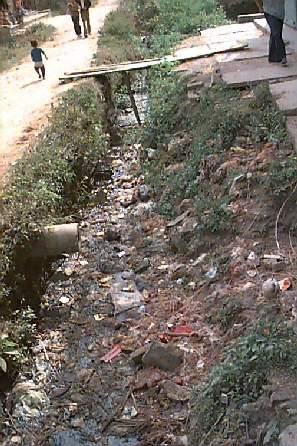

Short description of the village
A report submitted by the participants from Thimi
| Thimi
lies between Kathmandu and Bahktapur. It has grown from a hill to the mainroad. The
hygenic situation is far from ideal. It is dirty, filthy, dusty, but a wonderful beauty
and grandeur. It is a a very old place, beatiful old temples, wood carving on the houses.
It could well be a tourist attraction like Bahkapur. Along the mainroad small industry is florishing, a small hospital, shops, etc. Thimi counts around 3000 houses, with 14.000 inhabitants on less than 30 ha. |
Madhyapur Thimi which is one of the oldest communities of the Kathmandu Valley is situated in the middle of the historical city called Bhaktapur and the capital city Kathmandu. Like other old cities this city is also situated on elevated land and therefore one has to climb up to reach this city. Thimi occupies an area of 2 square kilometers and the area has been divided into 8 wards. This report has been prepared with special consideration to ward no. 11,12,13 and 14.
Although the area into consideration occupies an area of 1 sq. km., it has a population of about 1400 and it is a dense community. The community has a lot of problems. Problems of drinking water and wastewater management are the most critical ones. These two problems have caused other problems and therefore also these problems are serious. These frightening problems have inflicted negative impact on public health and environment and one can easily guess the kind of state the people of this community are living in. An effort of one single workshop can not analyse, identify and also solve the problems. Therefore, this report has been prepared with reference to wastewater management.
Major problems of wastewater management
In the community, in about 90% of the area sewer pipes have been laid for the collection of wastewater. It can be hoped that rest 10% area will also have sewerpipes. Therefore, there seems to be no major problem in conveyance and collection. Since there is no separate line for sanitary sewer and stormwater, there is very low flow in the dry season and very high flow in the rainy season in these sewer lines. Sometimes the flow in the sewer lines exceeds the capacity of the pipes and causes serious damage. The wastewater from the sewer lines is released in the open field. From the open field the wastewater joins gutters and small canals which finally merge into the Hanumante river. Because of lack of proper management of wastewater, following problems have been created.
A field observation was done in order to know the gravity of the situation. Various types of information was collected by filling up questionnaires in order to find out the potential solutions. Some of the aforesaid things are also based on the information thus collected. After interaction with various groups of the community overall state of the community and possible solutions were identified. The various groups were of old people, women, local authorities, and men. The points identified to be considered after the interaction with these people are following.
Technical need
There seems to be no significant problems in getting technical aspects. Due to Thimi's geophysical feature wastewater can be transported via gravity flow. A lot of public land is available. Besides, local authorities have realised the local situation and therefore, are committed to solve the problems by providing technical human resource. As has been said before, the main need of the community is to manage the wastewater collected by the drainage pipes already laid in the 90% of the area of the community. On top of that most of the drainage pipes were laid within past few years only. They are in good condition and need to be maintained.
Before managing wastewater it is essential to know the nature of the wastewater. Local authorities do not seem to be much aware of the nature of wastewater. After field observation it is believed that the wastewater is mostly organic. However, the non-biodegradable component is gradually increasing. Hanumante river receives a lot of industrial wastes. At Lhabaha area the wastewater is acidic due to the acidic effluent from the production of alcohol in households. An appropriate method of treatment should be sought for such wastewater. Besides, analysis of the cause of the failure of the treatment plant constructed by Plan International can provide some insight into the technicalities of wastewater treatment. Although there is a big problem of wastewater management, there is not any significant plan and programme to overcome it and the problem is growing. The problem has been compounded by the lack of sufficient water supply.
Cost of construction
A huge amount of fund may be needed in order to manage wastewater. However, this cost is far outweighed by the benefit that can be reaped from it. Local community has opinion that it is possible to contribute partial fund which can be much less as compared to the total amount needed. However, the local authorities are willing to contribute some from their side and local people may also contribute some labour. These in total may be enough to bear a significant portion of the total cost. Therefore, it is almost certain that a donor agency is needed to meet the large part of the financial need. Since the sewer drain has been laid only a little cost is needed for maintenance of the lines. Availability of the public lands will also lessen the financial burden of construction.
Management and operational cost
Since the wastewater problem has caused a lot of discomfort local people are committed to solve it. People are also aware of the need of the proper operation and maintenance of any project after implementation. There are several NGOs and clubs which have shown interest and they can also help in operation and maintenance. Similarly, user groups can be formed in order to make the project sustainable. Donation can be collected from the households and also minimum fees can be collected to meet certain operation and maintenance cost. In a nutshell, the cost of maintenance and operation of a project can be met by the local community.
Technical capability to operate and maintain
The community should be technically capable to operate and maintain the projects related to wastewater management If the community is not capable then all the effort could be wasted. Since the people of Thimi are educated they can understand simple technicalities about wastewater management Technical human resource is also locally available in order to run a project sustainable. With some training local people can also operate different equipment’s if needed. Therefore, this community is technically capable.
Social Acceptance
The community has suffered due to lack of wastewater management. Although the community is aware of adverse impact of unmanaged wastewater on health and environment it has not been able to solve the problem due to its complex nature. However, any step taken towards solving the problem will be highly appreciated by the community. The community knows that it is their problem and they are the ones who should take initiative towards managing the wastewater. Somehow this is not happening. In case any external institution can take the initiative the local community is ready to help as much as possible. They are also committed to appropriately manage any project. They strongly believe the projects can be run smoothly without disturbance. However, due to some previous incomplete projects local people sometimes raise doubts about upcoming projects. For example, since the treatment plant constructed by the Plan International was left incomplete, local people have become not only unsatisfactory but also angry.
Environmental impact
It is undisputed that unmanaged wastewater has caused adverse environmental impact. The wastewater has made the canals and Hanumante river highly polluted. Since the wastewater also flows in open canals it has also caused a lot of nuisance. This pollution has imposed harmful effects on public health. All the people suffer from diarrhoeal diseases. All of this has resulted into decreased living standard because a major portion of their income is used for medical treatment. Besides, the wastewater has also been used for irrigation which has imposed negative impact on the health of farmers and the crops as well and this has affected the overall economy of the community. The acidic wastewater has further heightened the problem. Since the water in the canals and creeks are polluted due to wastewater, farmers use stone tap, wells and piped supply for washing their vegetables and therefore drinking water shortage has increased. Besides, the signs of soil erosion and landslides due to rain have emerged and the overall physical feature may be damaged ultimately.
Just four images of the hygenic situation, pictures of the beauty of the place will be added later
 |
 |
| People working in the heavy polluted river. The Microtrix worms, that had grown during the rainy season now tried to escape from the water that got more concentrate after the monsoon | A path from the main road leading to Thimi (on the hill in the background. The "stream" on the left contained "water" flowing from the fields with open defecation ("shitting fields") |
 |
 |
| This man was cleaning the stream. He stood barefoo in a stinking, muddy water "flowing" from the shitting fields. | A combination of fecal and household off-fall |